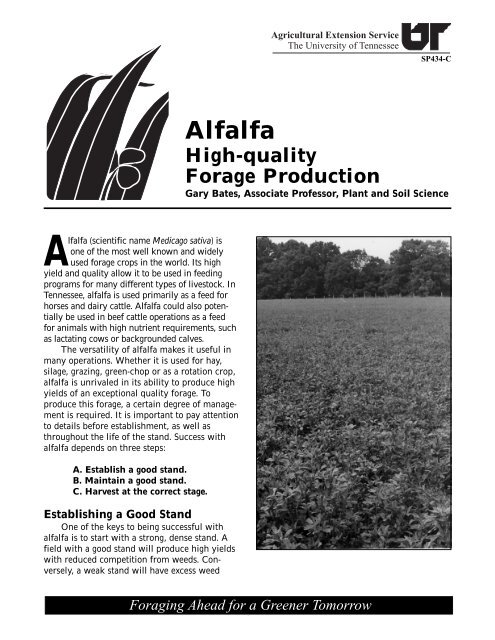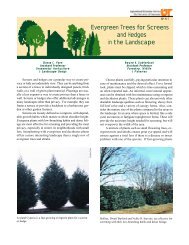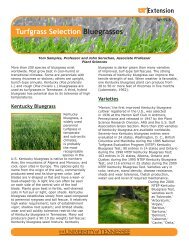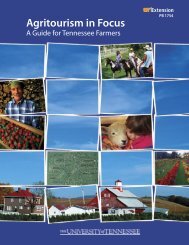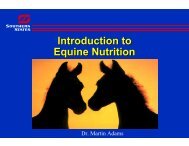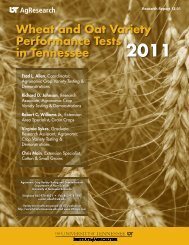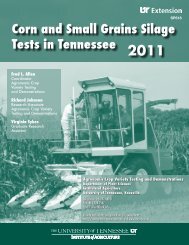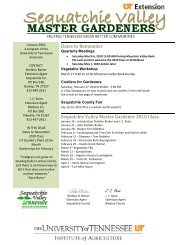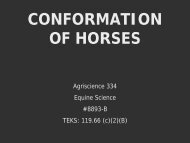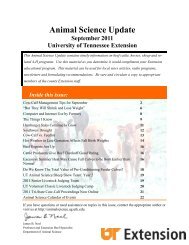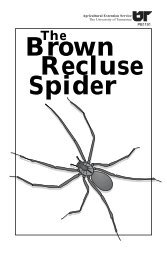Alfalfa - High-quality Forage Production - UT Extension - The ...
Alfalfa - High-quality Forage Production - UT Extension - The ...
Alfalfa - High-quality Forage Production - UT Extension - The ...
You also want an ePaper? Increase the reach of your titles
YUMPU automatically turns print PDFs into web optimized ePapers that Google loves.
Agricultural <strong>Extension</strong> Service<br />
<strong>The</strong> University of Tennessee<br />
SP434-C<br />
<strong>Alfalfa</strong><br />
<strong>High</strong>-<strong>quality</strong><br />
<strong>Forage</strong> <strong>Production</strong><br />
Gary Bates, Associate Professor, Plant and Soil Science<br />
<strong>Alfalfa</strong> (scientific name Medicago sativa) is<br />
one of the most well known and widely<br />
used forage crops in the world. Its high<br />
yield and <strong>quality</strong> allow it to be used in feeding<br />
programs for many different types of livestock. In<br />
Tennessee, alfalfa is used primarily as a feed for<br />
horses and dairy cattle. <strong>Alfalfa</strong> could also potentially<br />
be used in beef cattle operations as a feed<br />
for animals with high nutrient requirements, such<br />
as lactating cows or backgrounded calves.<br />
<strong>The</strong> versatility of alfalfa makes it useful in<br />
many operations. Whether it is used for hay,<br />
silage, grazing, green-chop or as a rotation crop,<br />
alfalfa is unrivaled in its ability to produce high<br />
yields of an exceptional <strong>quality</strong> forage. To<br />
produce this forage, a certain degree of management<br />
is required. It is important to pay attention<br />
to details before establishment, as well as<br />
throughout the life of the stand. Success with<br />
alfalfa depends on three steps:<br />
A. Establish a good stand.<br />
B. Maintain a good stand.<br />
C. Harvest at the correct stage.<br />
Establishing a Good Stand<br />
One of the keys to being successful with<br />
alfalfa is to start with a strong, dense stand. A<br />
field with a good stand will produce high yields<br />
with reduced competition from weeds. Conversely,<br />
a weak stand will have excess weed<br />
Foraging Ahead for a Greener Tomorrow<br />
1
pressure, possibly reduced yields and almost<br />
certainly a reduced stand life. To improve<br />
chances of having a strong stand, follow these<br />
recommendations:<br />
sticker material to help the inoculant stay on<br />
the seed during planting. Proper inoculation<br />
is required for root nodulation and nitrogen<br />
fixation.<br />
1. Select a well-drained soil. <strong>Alfalfa</strong> should<br />
be grown on what is considered the best<br />
soil on the farm. A deep, well-drained soil<br />
is needed for the alfalfa to develop a vigorous<br />
root system. Poor drainage will increase<br />
disease problems, result in more<br />
winter kill and cause lower yields and<br />
shorter stand life.<br />
If the selected site has a high amount of<br />
weed pressure, take time to concentrate on<br />
killing these weeds before the alfalfa is<br />
seeded. Perennial weeds such as curly dock<br />
and horsenettle are easier to deal with when<br />
no alfalfa is present.<br />
2. Fertilize and lime according to a soil<br />
test. <strong>The</strong> proper pH and fertility are essential<br />
for good seedling vigor. A pH of 6.5 - 7.0<br />
is recommended for alfalfa. If the pH is<br />
below 6.2, apply the recommended amount<br />
of lime at least six months before seeding. If<br />
the pH is below 5.8, seeding alfalfa no-till<br />
may not be desirable until a soil test shows<br />
an adequate pH. Be sure to apply the recommended<br />
amounts of phosphate and potash at<br />
seeding. Two pounds per acre of boron<br />
should also be applied.<br />
3. Select a recommended variety. More<br />
alfalfa varieties are available than any other<br />
hay crop. <strong>The</strong>re are large differences between<br />
varieties in yield potential, pest<br />
resistance and winter hardiness. One of the<br />
biggest mistakes that can be made is to pay<br />
attention to all the other details in establishment,<br />
and then decide to try and save a little<br />
money by selecting uncertified seed or seed<br />
of an inferior variety. Check with your local<br />
<strong>Extension</strong> office for the current list of recommended<br />
alfalfa varieties.<br />
Most recommended varieties are preinoculated<br />
with the proper Rhizobium bacteria.<br />
If the seed is not coated, be sure to<br />
apply alfalfa inoculant to the seed prior to<br />
planting. Consider using some type of<br />
4. Place the proper amount of seed into a<br />
good seedbed. <strong>Alfalfa</strong> should be seeded at<br />
the rate of 15 to 20 pounds of seed per acre<br />
for a pure alfalfa stand. <strong>The</strong> alfalfa can be<br />
seeded into a prepared seedbed, or seeded<br />
no-till into a killed sod. If no-till methods are<br />
to be used, be sure that all existing vegetation<br />
has been chemically killed. Seed should<br />
be placed 1 /4 to 1 /2 inch deep.<br />
In many cases, grasses must be seeded<br />
with the alfalfa to reduce soil erosion during<br />
stand establishment. In this situation, use 15<br />
pounds of alfalfa with six pounds of either<br />
orchardgrass or tall fescue, or four pounds<br />
of timothy. If tall fescue is used, be sure to<br />
use an endophyte-free variety. <strong>The</strong> endophyte<br />
can still result in reduced performance<br />
in animals grazing or consuming hay<br />
from infected tall fescue, even if it is in a<br />
mixture with alfalfa. <strong>The</strong> effect of the<br />
endophyte may be reduced because of the<br />
alfalfa, but animal performance will be<br />
superior when an endophyte-free tall fescue,<br />
orchardgrass or timothy variety is used.<br />
5. Seed at the proper time. <strong>Alfalfa</strong> can be<br />
seeded in both the spring and fall in Tennessee.<br />
In the past, the predominant time of<br />
seeding has been fall. Fall seedings usually<br />
need six to eight weeks to germinate and<br />
grow before the first hard freeze. <strong>Alfalfa</strong><br />
should be seeded from August 15 to September<br />
15. Do not plant before adequate moisture<br />
is available in the soil.<br />
It is important for the alfalfa to have<br />
adequate growth going into the winter<br />
because of the potential damage from<br />
sclerotinia stem and crown rot. Crown rot is<br />
a fungal disease that infects plants in the<br />
late fall/early winter. Young, fall-seeded<br />
plants are at the greatest risk of death<br />
because they are not big enough to withstand<br />
the disease. Early seeding allows<br />
plants to be larger, giving them a better<br />
chance to withstand the disease. However,<br />
Foraging Ahead for a Greener Tomorrow<br />
2
early seeding does not necessarily ensure<br />
immunity. If sclerotinia has been a problem<br />
previously, consider establishing the alfalfa<br />
in the spring. If you plan to use no-till, avoid<br />
fall planting. Seedlings planted no-till do not<br />
establish as quickly as those planted conventionally,<br />
and will be smaller and more<br />
susceptible to crown rot damage.<br />
If you will be spring seeding, plant from<br />
March 1 to May 1. Spring seedings generally<br />
require an early application of a grass<br />
herbicide to decrease crabgrass competition.<br />
Be sure to plant the alfalfa after the danger<br />
of frost has passed.<br />
6. Control weeds during establishment.<br />
Competition from weeds can be one of the<br />
major factors limiting alfalfa stand establishment.<br />
Most weed species grow very<br />
rapidly as seedlings, and are more competitive<br />
than the alfalfa seedlings for light and<br />
nutrients. Weeds such as henbit, chickweed<br />
and annual ryegrass can be problems in<br />
fall-seeded alfalfa, while crabgrass is a<br />
major competitor in spring-seeded alfalfa.<br />
Herbicides can be used to reduce this<br />
competition. If a grass is seeded with the<br />
alfalfa, grass herbicides cannot be used.<br />
Check with your local <strong>Extension</strong> office<br />
about current alfalfa herbicide recommendations,<br />
or obtain <strong>Extension</strong> PB 1521 Hay<br />
Crop and Pasture Weed Management for<br />
additional information.<br />
Maintaining a Good Stand<br />
Managed correctly, a stand of alfalfa should<br />
last five years or longer. Just as with the establishment<br />
phase, attention to detail during the<br />
life of the stand is important in getting good<br />
yields for several years.<br />
Fertility<br />
Soil samples should be taken every two or<br />
three years to determine how much lime, phosphate<br />
and potash need to be applied. Low fertility<br />
levels can cause stand loss and increased weed<br />
pressure. Apply two pounds per acre of boron<br />
each year. Nitrogen is not needed on alfalfa. In<br />
years between soil test, apply 60 pounds of phosphate<br />
and 190 pounds of potash per acre.<br />
<strong>The</strong> fertilizer can be applied any time of the<br />
year. Splitting the annual application for phosphate<br />
and potash do not provide any economic<br />
benefit; one yearly application is sufficient.<br />
Insect and Weed Control<br />
<strong>The</strong> alfalfa weevil and potato leafhopper<br />
are the two major pests in alfalfa. <strong>The</strong> alfalfa<br />
weevil is usually a problem in March and<br />
April. Weevil larvae can be found in the growing<br />
tips of stems. Insecticides should be applied<br />
when 40 -50 percent of plants show some<br />
leaf damage. <strong>The</strong> potato leafhopper is usually a<br />
problem during the mid- to late-summer period.<br />
Fields should be scouted regularly during<br />
the growing season for both of these pests to<br />
monitor insect damage. Check with your local<br />
<strong>Extension</strong> office for current insecticide recommendations.<br />
Weed pressure should be minimized<br />
during the season to maintain healthy and<br />
productive stands. A dense, vigorous stand is<br />
one of the best weed control measures possible,<br />
but certain weeds (such as crabgrass)<br />
tend to be problems that develop every year,<br />
no matter how thick the stand of alfalfa is.<br />
Monitor the fields regularly to determine weed<br />
pressure and the need for herbicide application.<br />
Check with your local <strong>Extension</strong> office for<br />
herbicide recommendations for specific weed<br />
problems, or obtain <strong>Extension</strong> PB 1521 Hay<br />
Crop and Pasture Weed Management.<br />
Reseeding a Thinning Stand<br />
As alfalfa stands get older, plants tend to die<br />
out and the stand becomes thin. Research has<br />
shown that when there are less than 40-50<br />
stems per square foot, yield will be reduced. If a<br />
stand is getting thin, yields can be maintained<br />
by either drilling orchardgrass or red clover into<br />
the stand. This will provide the extra forage<br />
plants needed to get the maximum yield from a<br />
field. Four pounds of timothy or 6 pounds per<br />
acre of orchardgrass or endophyte-free tall<br />
fescue can be seeded in September to improve<br />
the stand thickness.<br />
It is not recommended to try and “thicken<br />
up” a stand of alfalfa by adding alfalfa seed to an<br />
established stand. <strong>The</strong> old alfalfa plants produce<br />
a toxin that keeps any new alfalfa seedlings from<br />
Foraging Ahead for a Greener Tomorrow<br />
3
ecoming established. This is known as<br />
autotoxicity. A field needs to be completely out of<br />
alfalfa for at least one year (and preferably two)<br />
before being reseeded to a new stand.<br />
Harvesting at the Correct Stage<br />
<strong>The</strong> forage from alfalfa can be used in<br />
many different ways, including hay, silage and<br />
grazing. <strong>The</strong> most important factor in getting<br />
high <strong>quality</strong> forage from alfalfa is to harvest in a<br />
timely manner. Just as with any other forage, as<br />
alfalfa matures, it has increased fiber levels and<br />
decreased protein.<br />
<strong>The</strong> yield of an alfalfa stand is dependant<br />
upon several things, such as variety, moisture,<br />
fertility and harvest management. Yields can<br />
normally be expected to range between four and<br />
six tons of dry matter per acre. Table 1 shows<br />
the yield from alfalfa variety tests in several<br />
locations across Tennessee.<br />
New spring seedings should be harvested<br />
when they reach full bloom. This allows the<br />
plants to become well established and develop<br />
a good root system. All later harvests<br />
should be made when 10 percent of the<br />
plants are blooming.<br />
Fall seedings and established stands can be<br />
harvested at the bud stage for the first cutting,<br />
and then at the 10 percent bloom stage for all<br />
later cuttings.<br />
<strong>The</strong> last harvest in the fall should be made<br />
before mid-September. This will allow plants time<br />
to build up root carbohydrate reserves. Harvests<br />
can be made later than this if the plant is at the full<br />
bloom stage. <strong>The</strong> alfalfa can be grazed during the<br />
winter to remove any top growth, if the alfalfa is<br />
dormant. Be careful to not graze when the field<br />
could be damaged by trampling.<br />
Summary<br />
<strong>Alfalfa</strong> is a high-<strong>quality</strong> forage crop that can<br />
be used in many different ways. However, it<br />
takes a higher level of management than many<br />
of the grass pastures in Tennessee. <strong>The</strong> key to<br />
being successful with alfalfa is attention to<br />
details. Fertility, weed control and proper harvest<br />
methods need to be priorities. While alfalfa<br />
is one of the more expensive and difficult crops<br />
to grow and maintain, it is unrivaled in terms of<br />
yield of high-<strong>quality</strong> forage.<br />
Table 1. Average dry matter yield (tons/acre)<br />
of alfalfa variety tests in Tennessee during<br />
1993-96.<br />
Location<br />
Number of<br />
v arieties<br />
1993<br />
1994<br />
1995<br />
1996<br />
Knoxville<br />
23<br />
5.<br />
9 6.<br />
9 5.<br />
5 4. 9<br />
Spring<br />
Hill 21<br />
5.<br />
6 6.<br />
1 6.<br />
6 4. 8<br />
Crossville<br />
2<br />
2 ---<br />
. 6<br />
4 6.<br />
1 4. 6<br />
Graves and co-workers. 1996 Performance of forage<br />
crop varieties. University of Tennessee Agri. Exp.<br />
Stat. Research Report 97-04.<br />
SP434C-5M-7/98 E12-2015-00-031-99<br />
A State Partner in the Cooperative <strong>Extension</strong> System<br />
<strong>The</strong> Agricultural <strong>Extension</strong> Service offers its programs to all eligible persons<br />
regardless of race, color, national origin, sex or disability and is an Equal Opportunity Employer.<br />
COOPERATIVE EXTENSION WORK IN AGRICULTURE AND HOME ECONOMICS<br />
<strong>The</strong> University of Tennessee Institute of Agriculture, U.S. Department of Agriculture,<br />
and county governments cooperating in furtherance of Acts of May 8 and June 30, 1914.<br />
Agricultural <strong>Extension</strong> Service<br />
Billy G. Hicks, Dean<br />
Foraging Ahead for a Greener Tomorrow<br />
4


